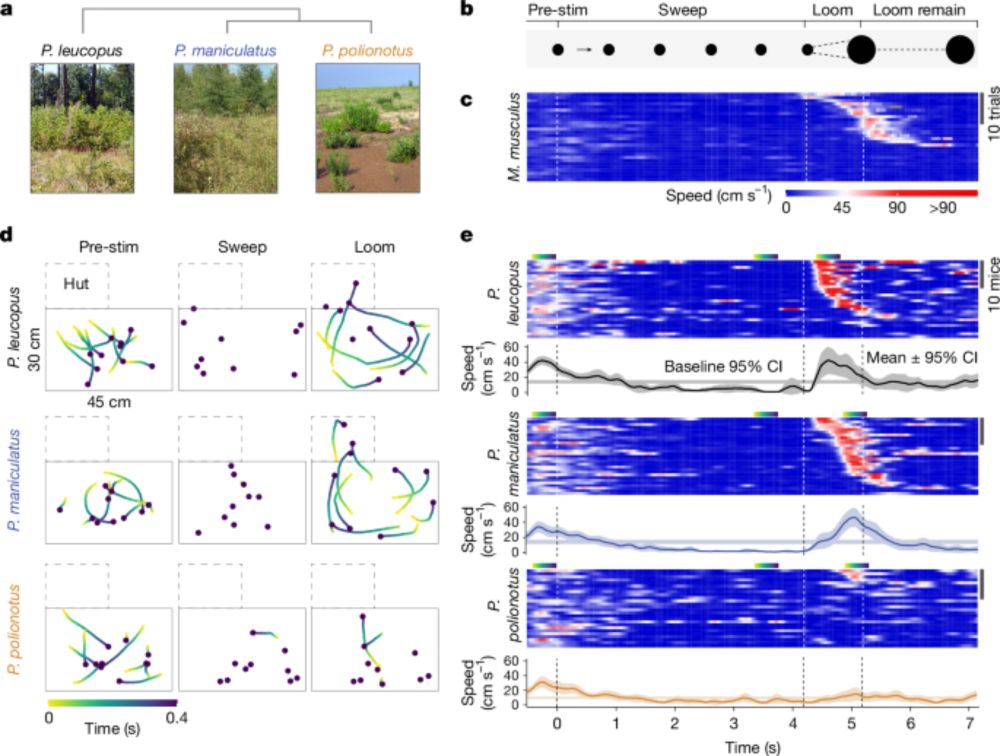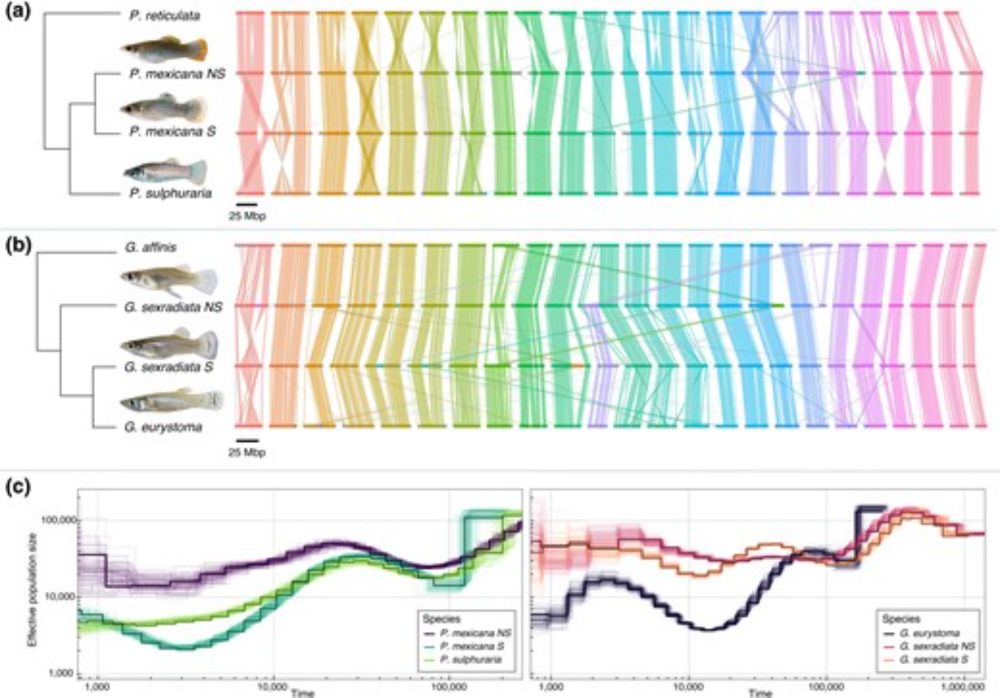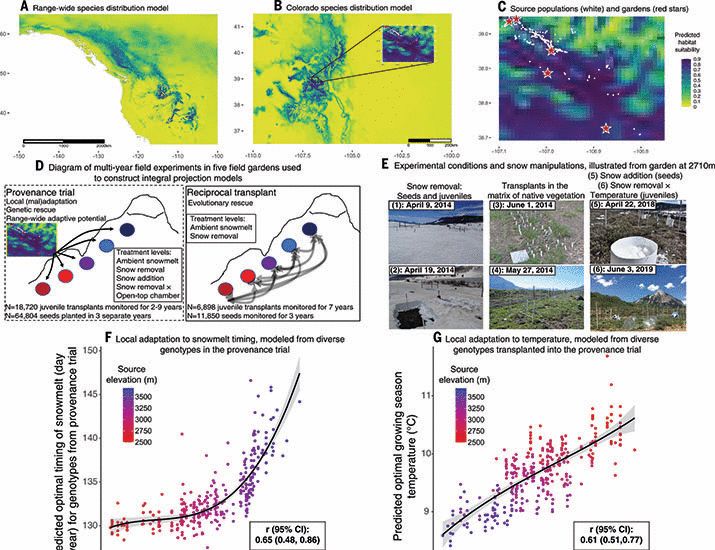Check out our new paper in Nature describing trends in US freshwater fish biodiversity! Great to be part of such an amazing team.
25.09.2025 23:37 — 👍 15 🔁 6 💬 0 📌 0

Most bilaterians keep photoreceptor types separate.
But vertebrate eyes are a mash-up:
🪡Ciliary (rods & cones) and
💈Rhabdomeric (ganglion, amacrine, horizontal)
…all packed into a multilayered circuit.
2/n
12.09.2025 12:58 — 👍 6 🔁 2 💬 1 📌 0

Blackrock, Vanguard und die State Street Corporation sind global die größten Investoren und heißen in der Sozioökonomie Big Three: die großen Drei. Gemeinsam verwalten sie 2025 ein Kapital von 27,3 Billionen US Dollar. Zum Vergleich das Bruttoinlandsprodukt (BIP) Deutschlands (4,3 Billionen US Dollar), der EU (17,9 Billionen US Dollar) und der USA 2024 (29,2 Billionen US Dollar). Quelle: GCO für Max-Planck-Gesellschaft)
Die Macht von #Blackrock, #Vanguard & Co: Vermögensverwalter, die passiv in #ETFs investieren, sind in vielen Unternehmen größte Anteilseigner – eine dominierende Stellung, die sie unternehmerisch und politisch auszunutzen versuchen. mpg.de/25364502/pas... w/th
@mpifg.bsky.social
12.09.2025 13:04 — 👍 17 🔁 6 💬 1 📌 2

Flyer advertising the BonnBrain Conference 2026, "From Genes to Circuits and Behavior".
Application is open! Come join us and our fantastic line-up of speakers next year in March in Bonn!
08.09.2025 12:00 — 👍 31 🔁 21 💬 0 📌 1

🤩 Join us for the next TIBBE seminar:
Evolution of brain cell types.
September 10, 2–3pm UTC
This event brings together 2 outstanding evolutionary and developmental neuroscientists who will present their work, followed by an interactive discussion with the audience: www.crowdcast.io/c/evolution-...
04.09.2025 14:28 — 👍 18 🔁 17 💬 1 📌 6

Incredibly excited for my first cover! 🐟🧬👁️ We reviewed the data on fish color vision and quantified the magnitude and factors influencing plasticity in opsin gene expression! Thanks to @jexpbiol.bsky.social for highlighting our work, Isaac Szabo for providing the picture and my great advisor!🎉🎉
30.08.2025 10:30 — 👍 4 🔁 2 💬 0 📌 0
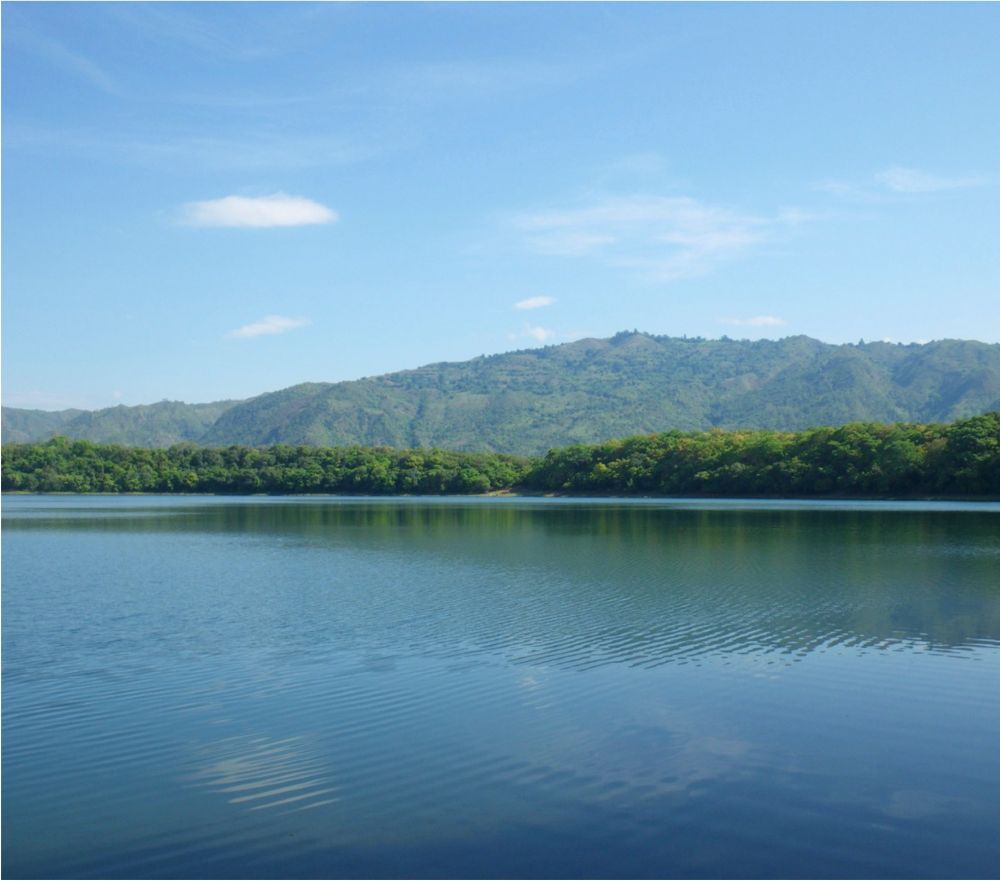
Lake Masoko in Southern Tanzania, also known as Lake Kisiba, is only ~40m deep and 600m in diameter. It was formed around 50,000 years ago, and is isolated from all nearby rivers and lakes. Genetic data suggest it was colonised by Astatotilapia calliptera around 10,000 years ago.

In Lake Masoko, Astatotilapia calliptera has two ecotypes. The shallow living "littoral" ecotype has yellowish males, while the deep living "benthic" ecotype has blueish males. Recently published research led by Madeleine Carruthers and colleagues shows how these fish occupy different light regimes, and have correspondingly different visual sensitivities. Males of these ecotypes have brightly coloured eggspots, used to signal their prowess. The colours of those spots have shifted to maximise their visibility to other fish of the same ecotype. Genetic data suggest these ecotypes are largely reproductively isolated, and started to separate only 1000 years ago. Photos are kindly provided by Ad Konings.
In crater Lake Masoko one fish species is splitting into shallow and deep-living ecotypes occupying different light environments. New research shows their visual systems are diverging, and how colours of male eggspots have changed to maximise their visibility. doi.org/10.1093/molb...
28.08.2025 19:51 — 👍 57 🔁 12 💬 3 📌 1

SAVE THE DATE: We, the @mpiforbi.bsky.social and @mpibiochem.bsky.social, are opening our doors for you on October 25! Tours, talks, experiments – Join us to learn more about us and our science!
More information: mpi.lineupr.com/tdot/
28.08.2025 13:37 — 👍 3 🔁 2 💬 0 📌 1

our paper on how light pollution affects bird vocal behavior is out today in Science!!
w/ @brentpease.bsky.social
www.science.org/doi/10.1126/...
21.08.2025 23:03 — 👍 119 🔁 49 💬 5 📌 6

The CCIB will welcome over 1,900 scientists to explore the origin and evolution of life - CCIB
Barcelona to host the Leading Event in Evolutionary Biology ESEB 2025
🧬 Today starts the most relevant event in evolutionary biology: the European Society for Evolutionary Biology (ESEB) Congress (@eseb2025.bsky.social @eseb.bsky.social).
🔝 #IRBBarcelona's group leader @tonigabaldon.bsky.social is the chair of this major event that will gather +1900 participants.
👇
18.08.2025 11:00 — 👍 19 🔁 8 💬 1 📌 0

🚨Our new paper is out NOW in @jexpbiol.bsky.social 👀 Here we show that cuttlefish use visual contrast cues to inform their 3D camouflage, but these contrast cues can derive from true background features as well as exposure to dynamic lighting patterns. 🦑🔆
🔗 doi.org/10.1242/jeb....
15.08.2025 13:45 — 👍 6 🔁 6 💬 2 📌 0
All early-career researchers affiliated with the SMBE are welcome to apply to the SMBE Fellows Program before August 31. Please find more details on the program and the application procedure on our website:
🔗 www.smbe.org/smbe-fellows...
14.08.2025 16:58 — 👍 10 🔁 8 💬 0 📌 0

Our paper showing that variation in transcription factor binding sites underlies the majority of additive genetic variance for phenotypic variation in maize is finally out!
Sadly they didn't use our suggested cover image below (made by the inimitable Andi Kur).
www.nature.com/articles/s41...
11.08.2025 14:29 — 👍 253 🔁 75 💬 6 📌 5

Two convict cichlids, one in front of the other, swimming above a bed of sand and gravel. Photo credit: Ad Konings.
We can't alter our vision depending on the colour of light around us, but fish can, & now scientists from @NotreDame reveal that fish fine tune their vision throughout life as the colour of the light changes, also depending on their lifestyle and diet
journals.biologists.com/jeb/article/...
02.07.2025 07:03 — 👍 10 🔁 6 💬 3 📌 0
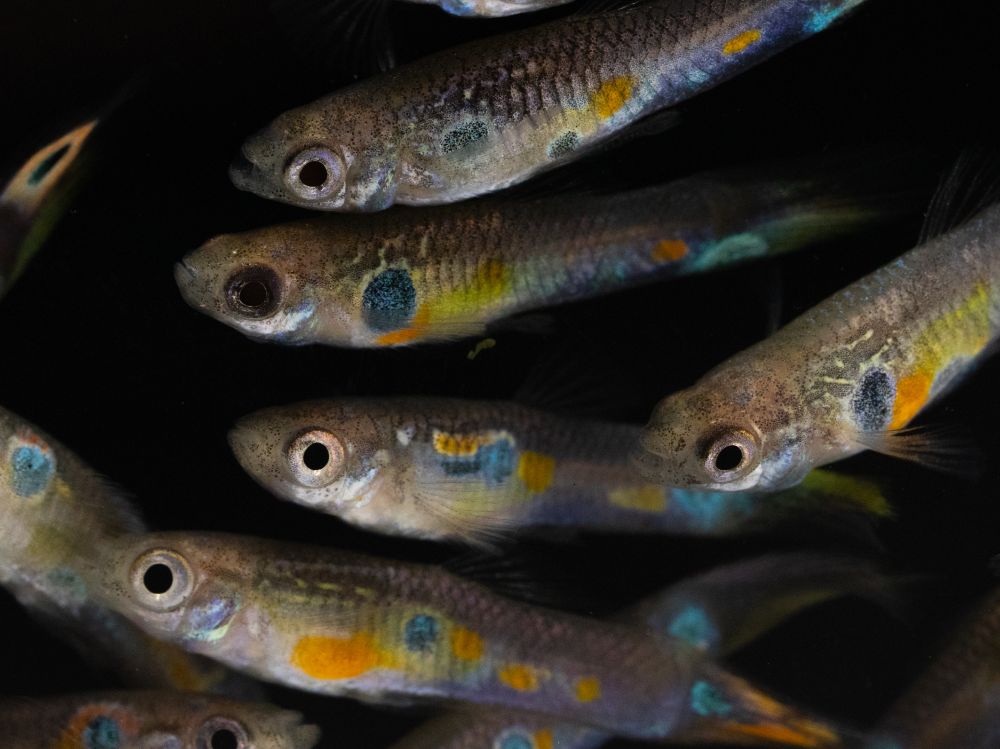
Photo of guppy males from lab population, each showing a unique combination of black and orange ornaments. Photo by Wouter van der Bijl.
🚨 Super exited to see our paper on the inheritance and genetic basis of guppy color variation come out in @natecoevo.nature.com rdcu.be/eugWV
Guppy males have enormous variation in color patterns, with many combinations of ornamental spots and stripes. But where does all this variation come from?
01.07.2025 18:03 — 👍 106 🔁 41 💬 3 📌 4
Started interviewing folks, but there’s still time to apply!
Please share and get in touch if you think this would be a good fit for you or someone you know!
25.06.2025 14:23 — 👍 3 🔁 3 💬 0 📌 0

In our most recent episode we talk with Bill Zamer and Sam Scheiner, two former BIO program officers at the NSF, about the recently proposed 56% budget cut to the NSF.
🎙️Listen now: bigbiology.substack.com/p/savensf-ep...
#scicomm #science #sciencecommunication #SaveNSF #NSF
25.05.2025 01:21 — 👍 39 🔁 22 💬 0 📌 2

The tuatara and many lizards possess a parietal eye, where non-visual opsins are expressed. Romero & @fsjsouza.bsky.social compared 60+ genomes to study the evolution of non-visual opsins, suggesting a functional role associated with the parietal eye.
🔗 doi.org/10.1093/gbe/evaf058
#genomes #opsins
15.05.2025 12:31 — 👍 6 🔁 2 💬 0 📌 0
06.05.2025 14:24 — 👍 7 🔁 2 💬 0 📌 0
Now published!!!! www.nature.com/articles/s41...
28.04.2025 12:48 — 👍 177 🔁 69 💬 13 📌 3

Check out the latest @evolletters.bsky.social cover article: Parallel and convergent evolution in genes underlying seasonal migration, by Zamudio-Beltrán and colleagues
academic.oup.com/evlett/artic...
14.04.2025 21:10 — 👍 6 🔁 2 💬 0 📌 0

Left: Using genome-wide association analyses, VanKuren and colleagues show that separate loci within the K locus control a white-yellow color switch and contribute to variation in male preference, respectively, in a polymorphic population of Heliconius cydno in Ecuador. The full geographical range of H. cydno is shown on the map in light blue. The approximate location of the color pattern gene Aristaless-1 is shown for reference; other genes (not shown) are also present in the K locus, including some that are differentially expressed during the development of visual processing regions of the insect brain. In this and other H. cydno populations, white-yellow wing coloration correlates with the proportion of inhibited UV-photoreceptors, suggesting a compelling mechanism for the evolution of visual preference. Right: Individual ommatidia in the butterfly eye are composed of multiple photoreceptors. Inter-photoreceptor synaptic connections are known to exist within the lamina, the upper layer of the optic lobe, itself the region of the insect brain responsible for initial visual processing.
Bright colors observed across the animal world are often used during mate choice. @dickmerrill.bsky.social explores a @plosbiology.org study of genetic & neural mechanisms contributing to evolution of visual mating decisions in Heliconius butterflies 🧪 Paper: plos.io/4iHQDRd Primer: plos.io/4ipW7QS
13.03.2025 08:59 — 👍 29 🔁 9 💬 0 📌 0
Dopest cover ever
12.03.2025 21:18 — 👍 54 🔁 11 💬 0 📌 0
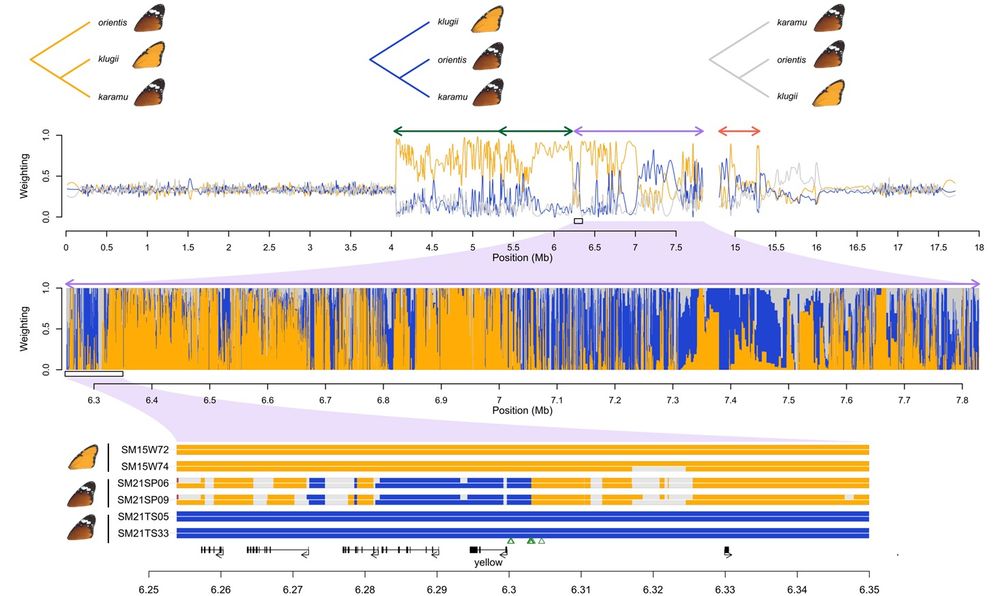
Top: Topology weightings across chr15 showing how the karamu haplotype is related to the klugii and orientis haplotypes. Upper panel shows three possible rooted genealogical topologies. Second panel shows weights for each topology along the chromosome, smoothed with a 20 kb span. Arrows above the plot indicate the locations of inversions. Third panel shows unsmoothed topology weightings across a 1.5 Mb region corresponding to Inversion 2. Bottom: Ancestry painting across a 100 kb region within Inversion 2, showing ancestry tracts for two homozygous karamu individuals compared to two representative individuals homozygous for the orientis and klugii haplotypes. Coding regions are indicated below the plot, with the candidate gene for background colouration yellow indicated. Green triangles represent the top 10 SNPs for background colour in our GWAS. There is evidence for recombination throughout the supergene region, and specifically in the vicinity of yellow, consistent with the hypothesis that orientis ancestry at this locus (i.e., the B allele) is associated with darker colouration in karamu individuals.
Dynamics of a supergene. A study of the BC supergene in wing color morphs of the African monarch #butterfly by @rishidekayne.bsky.social &co reveals dynamic evolution of #supergene haplotypes, fueled by incomplete recombination suppression 🧪 @plosbiology.org plos.io/3DiFhnL
03.03.2025 10:00 — 👍 53 🔁 31 💬 0 📌 2
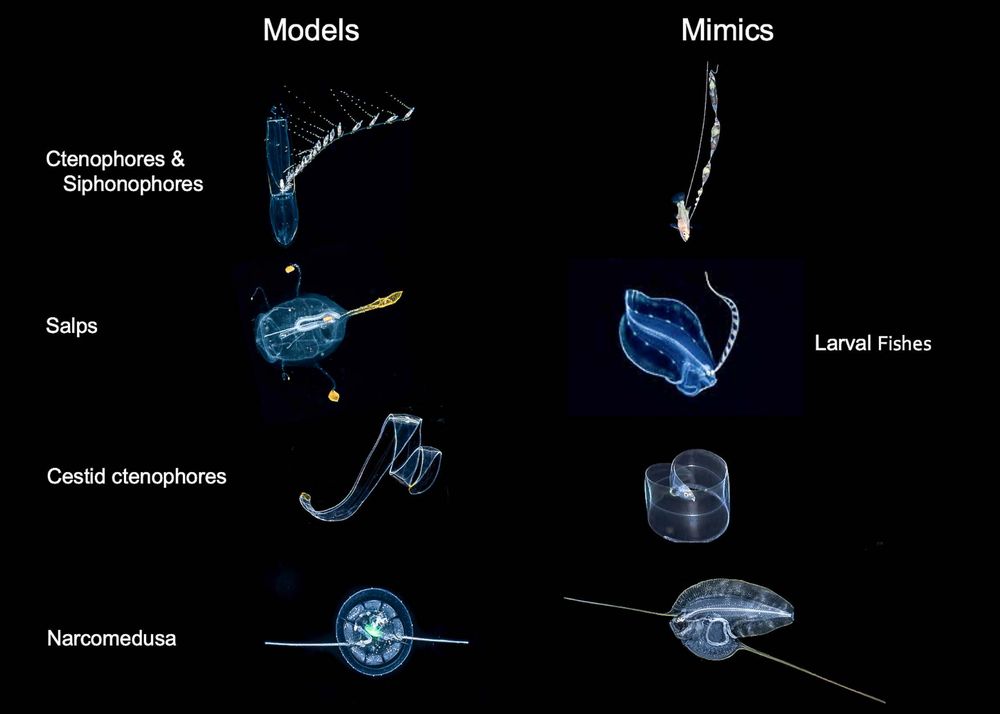
Figure 7. Mimics and models based on Greer et al (2016) with live blackwater images substituted: see other figures for
photographer credits, except the salp (AW).
Model organisms on left including salps and ctenophores and larval fish mimics shown on the right
Putative Batesian mimicry of gelatinous zooplankton by larvae of marine fishes: a closer look based on in-situ images by blackwater photographers
Johnson et al. 2025
Larval fishes appear to mimic invertebrates as seen by deep ocean divers after sunset
oceansciencefoundation.org/josf42d.html...
25.02.2025 01:25 — 👍 85 🔁 31 💬 5 📌 5
Ecology and evolutionary biology, mainly fishes, climate change, conservation
Assistant Professor @uarizona; macro-evolution, data science, and some ecology; Lab website: https://datadiversitylab.github.io/; Blog: https://ghost.cromanpa.synology.me/
Experimental & theoretical neuroscientists collaborating to understand brainwide circuits for complex behavior. internationalbrainlab.com
This is the channel of the Max Planck Institute for Biological Cybernetics. We conduct basic research in the neurosciences and belong to the Max Planck Society, a global top 5 research organization with its 84 Max Planck Institutes and 31 Nobel Laureates.
Sensory biology, genetics, behavior, and evolution (especially in the Twilight Zone) | Incoming Assistant Professor, NJIT Biological Sciences (Fall '26) | Current postdoc, University of Lausanne, Benton Group
https://himmellab.org
into brain evolution & development, open science, art & science https://www.youtube.com/watch?v=6hMNZHsrNHw, music, making, javascript, contemporary dance https://www.youtube.com/watch?v=OZfHj7F2FzQ
website: katjaq.github.io
Die DGN ist die Stimme der Neurologie. Wir fördern Wissenschaft, Forschung, Lehre sowie Fort- und Weiterbildung in der Neurologie. Wir prüfen die wissenschaftliche Debatte und beteiligen uns an der gesundheitspolitischen Diskussion.
Official account of the Max Planck Society. Devoted to basic #research in #physics #astronomy #chemistry #biology #earthsciences #materialscience #mathematics #socialsciences and the #humanities; Imprint: https://www.mpg.de/imprint
Promoting the study of the neural bases of behavior.
Lorry Lokey Chair & Professor of Bioengineering, Knight Campus, University of Oregon. evolution | ecology | genetics | genomics | evodevo | systems biology | epigenetics | host-microbe. Educational empowerment & increasing opportunities for all in science.
NERC Research Fellow at Uni. Glasgow |
Evolutionary Genomics & Gene Regulation | Sometimes fisheries & pathogen genetics | Mostly fish & lampreys 🐟
Scientific illustrator, educator, biologist
🇵🇱 in 🇫🇮
Drawing to explain and inspire
Commissions open: DM
Visual design portfolio:
https://www.behance.net/dorotdesigns
she/her
We promote the study of animal behaviour, organise conferences, fund research & support the teaching of animal behaviour. Co-publisher of #AnimalBehaviourJournal. Posts by @raccoonologist.bsky.social. For meeting posts, follow @asab-meetings.bsky.social
incoming Assistant Professor and Principal Investigator at NYU Biology | currently postdoc at UC Berkeley | proud Sudmant lab member | typos and views are my own & I can be wrong :)
https://joanocha.github.io/
evolutionary genomics; adaptation; speciation; behavior 🧬🐠🐭
Assist. Prof. at WashU in St. Louis Biology
he/him
Assistant Prof, UCRiverside EEOB. Prev: WRF postdoctoral fellow, Stanford PhD. genomics of 🦁,🐯, and 🐻 (oh my). she/her
Science Events helps you organise a scientific conference or workshop. Use our platform to organise your next event! Visit our platform at https://www.sci.events
Mexican Historian & Philosopher of Biology • Postdoctoral Fellow at @theramseylab.bsky.social (@clpskuleuven.bsky.social) • Book Reviews Editor for @jgps.bsky.social • #PhilSci #HistSci #philsky • Escribo y edito • https://www.alejandrofabregastejeda.com












